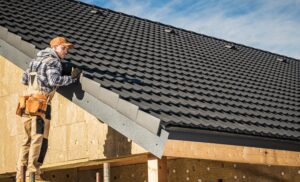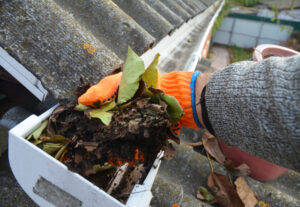A Guide to Restoring Your Storm-Hit Roof

*Updated April 3rd, 2025
Each year, severe storms cause billions of dollars in damage to homes across the United States. According to the Insurance Information Institute, in 2021 alone, insured losses from wind and hail storms reached a staggering $26.7 billion. One of the most vulnerable components of a home during these extreme weather events is the roof.
Roof damage due to severe storms can range from a few missing shingles to major structural issues, and it’s crucial to take immediate action to prevent further damage and avoid the need for extensive, expensive repairs. In this article, we’ll guide you through the steps to take when your roof is damaged by a storm, from assessing the damage to filing an insurance claim and finding the right contractor to restore your roof to its optimal condition.
Damage Evaluation
After a storm passes, the first step is to assess the extent of the damage to your roof. If it’s safe to do so, inspect your roof from the ground using binoculars or a drone. Look for missing, cracked, or curled shingles, as well as any visible holes or leaks. It’s also a good idea to check your attic for any signs of water damage or light coming through the roof.
If you notice significant damage or suspect structural issues, it’s best to call a professional roofing contractor for a thorough inspection. They have the expertise and equipment to safely and accurately evaluate the extent of the damage and recommend the appropriate repairs.
Quick Temporary Fixes
While waiting for a professional assessment or repairs, it’s important to take temporary measures to prevent further damage to your home. If you notice any leaks or holes, you can apply a temporary patch or tarp to the affected area. This will help minimize water damage and protect your home’s interior until permanent repairs can be made.
However, it’s important to remember that temporary fixes are just that – temporary. They are not a substitute for professional repair or replacement of your roof. Ignoring the need for proper repairs can lead to more extensive and costly damage in the long run.

Find a Contractor
Once you’ve filed an insurance claim, the next step is to find a reputable and experienced roofing contractor to handle the repairs or replacement. Here are some tips for choosing the right contractor:
- Ask for referrals from friends, family, or neighbors who have had similar work done.
- Check the contractor’s credentials and licenses, and ensure they are insured and bonded.
- Request quotes from multiple contractors and compare their estimates, services, and warranties.
- Verify that the contractor is familiar with your type of roof and the specific materials used.
- Ask for references and check online reviews to gauge their reputation and customer satisfaction.
- Ensure the contractor obtains the necessary permits and follows local building codes.
Factors That Affect Storm Damage on a Roof
1. Storm Strength
The intensity of a storm, including wind speeds and precipitation levels, plays a significant role in the degree of damage sustained by your roof. Stronger storms with higher wind gusts or larger hail can cause more severe damage.
2. Wind
High winds can tear off shingles, loosen flashing, and even compromise the structural integrity of your roof. Wind damage can also create entry points for water, leading to interior damage.
3. Hail Size
Hail can cause significant damage to your roof, especially if the hailstones are large. Hail can crack, dent, or puncture shingles, leaving your roof vulnerable to water intrusion and further deterioration.

4. Roof Material
The type of roofing material can affect how well it withstands storm damage. For example, asphalt shingles may be more susceptible to wind damage than tile or metal roofs, while metal roofs may be more prone to denting from hail.
5. Roof Slope
The pitch or slope of your roof can influence how well it sheds water and debris during a storm. Steeper roofs are generally better at shedding water and debris, while low-slope or flat roofs may be more prone to ponding water and debris accumulation.
6. Barriers
Trees, fences, or other structures near your home can act as barriers, potentially deflecting or reducing the impact of wind, rain, and hail on your roof.
Storm Damage Prevention Steps
There are some proactive steps you can take to reduce the chances of serious roof damage when bad weather strikes. With a little prep and regular maintenance, you can give your roof the best shot at surviving the next big storm. Let’s dive into some practical ways to protect your home.
1. Replace Damaged Shingles
Regularly inspect your roof and replace any damaged, curled, or missing shingles. This will help prevent water intrusion and further deterioration.

2. Clean Your Gutters
Clogged gutters can cause water to back up and potentially seep under shingles or cause ice dams in colder months, leading to roof damage. Keeping your gutters clean and free-flowing will help prevent water damage.
3. Trim Your Trees
Overhanging branches or trees too close to your home can pose a risk during storms. Trimming trees and removing any dead or overhanging limbs can help prevent them from falling on your roof and causing damage.
4. Check Your Property
Regularly inspect your property for any potential hazards or debris that could become projectiles during a storm. Secure or remove any loose items that could be picked up by high winds and cause damage to your roof.
Cost Considerations
The cost to repair storm damage to your roof can vary widely depending on the extent of the damage, the type of roof, and the materials required. Minor repairs, such as replacing a few shingles or patching small holes, may cost a few hundred dollars. However, more extensive damage or a full roof replacement can easily cost tens of thousands of dollars.
Factors that can influence the cost include:
- Size of the roof
- Type of roofing material
- Complexity of the roof design
- Accessibility and location of the property
- Labor costs in your area
It’s essential to obtain multiple quotes from reputable contractors to ensure you’re getting a fair price for the necessary repairs or replacement.
Homeowner’s Insurance Coverage for Storm Damage
Before Making Your Claim
Before filing a claim with your insurance company, consider the following:
- Deductible: Your policy likely has a deductible, which is the amount you’ll need to pay out of pocket before your insurance coverage kicks in. Ensure the cost of repairs exceeds your deductible, or it may not be worth filing a claim.
- Potential Rate Increase: Filing a claim can sometimes lead to an increase in your insurance premiums, especially if you’ve filed multiple claims in the past.
- Age of Your Roof: Some insurance policies may not cover the full cost of a roof replacement if your roof is nearing the end of its expected lifespan.
- Documentation: Document the damage thoroughly with photos and videos, and keep records of any communication with your insurance company.
Filing a Claim
If you decide to file a claim, follow these best practices:
- Notify Your Insurance Company Promptly: Most policies require you to report the damage within a specific timeframe, usually within a few days or weeks.
- Provide Detailed Information: Be prepared to provide your insurance company with details about the storm, the date and time of the damage, and a description of the extent of the damage.
- Cooperate with the Adjuster: When an adjuster is sent to inspect the damage, cooperate fully and provide any requested information or documentation.
- Review the Estimate: Carefully review the adjuster’s estimate and ensure it accurately reflects the necessary repairs or replacement.
- Negotiate if Necessary: If you disagree with the estimate or the proposed settlement, you may need to negotiate with your insurance company or seek assistance from a public adjuster or attorney.
Conclusion
Dealing with roof damage after a severe storm can be a stressful and overwhelming experience. However, by following the steps outlined in this article, you can navigate the process more smoothly and ensure your roof is repaired or replaced properly.
Remember to assess the damage promptly, apply temporary fixes to prevent further damage, contact your insurance company, and find a reputable roofing contractor. Additionally, consider taking preventative measures to minimize the risk of future storm damage to your roof.
By being proactive and informed, you can protect your home and provide peace of mind during the aftermath of a severe storm.
FAQ
How long do I have to file a claim after a storm?
Most insurance policies have a specific timeframe in which you need to report the damage, typically within a few days or weeks. Check your policy or contact your insurance company for their specific requirements.
Can I repair the roof myself?
While you can attempt minor repairs, such as replacing a few shingles, it’s generally recommended to hire a professional roofing contractor for significant damage or a full roof replacement. Attempting major repairs yourself could void your warranty or insurance coverage if not done properly.
Will my insurance cover the full cost of a new roof?
The coverage for a new roof can depend on factors such as the age and condition of your existing roof, the cause of the damage, and the specific terms of your policy. Your insurance company may only cover the cost of repairing the damaged portion or may apply depreciation to the replacement cost.
How long will it take to repair or replace my roof?
The timeline for repairs or replacement can vary depending on the extent of the damage, the availability of materials and contractors, and weather conditions. Minor repairs may take a few days, while a full roof replacement could take several weeks or longer, especially if there is a high demand for contractors after a major storm event.
Can I stay in my home during the repairs?
In most cases, you can stay in your home during minor roof repairs. However, if the damage is extensive or the repairs require significant work in your living spaces, your contractor or insurance company may recommend temporary relocation for safety reasons.

Anna has over six years of experience in the home services and journalism industries and serves as the Content Manager at MyHomePros.com, specializing in making complex home improvement topics like HVAC, roofing, and plumbing accessible to all. With a bachelor’s degree in journalism from Auburn University, she excels in crafting localized, comprehensive guides that cater to homeowners’ unique needs. Living on both coasts of the United States has equipped her with a distinctive perspective, fueling her passion for turning any house into a cherished home through informed, personalized decision-making.








